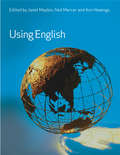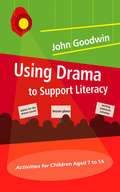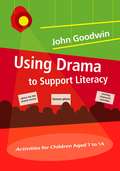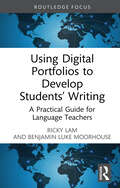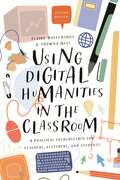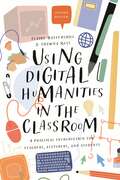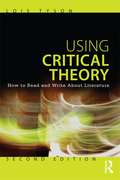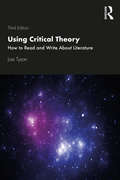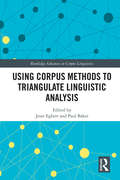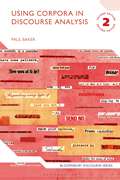- Table View
- List View
Using English
by Janet MaybinUsing English provides an invaluable introduction to the study of English for students of language and linguistics. It examines the way in which the English language is used today in different contexts and in many parts of the world, by both native and non-native speakers. Issues of language use in speech and writing, in work and play, and in persuading and informing are explored and illustrated with data and readings from around the English-using world. The reader is introduced to the adaptations and variations in English language use and to debates relating to how these are perceived and evaluated by different groups of users. For this second edition, key material from the earlier bestselling book, Using English: From Conversation to Canon, has been reorganized and updated, and entirely new material has been introduced. This new content is based on recent research in the field, as well as on contemporary thinking about how speakers and writers use the English language to accomplish a huge range of purposes in a variety of linguistic and cultural settings. Drawing on The Open University's wide experience of writing accessible and innovative texts, this book: explains basic concepts, easily located through a comprehensive index, includes contributions by experts in the field, such as Mike Baynham, Adrian Beard, Guy Cook, Sharon Goodman, Almut Koester, Janet Maybin and Neil Mercer, contains a range of source material and commissioned readings to supplement chapters.
Using English
by Janet Maybin Neil Mercer Ann HewingsUsing English provides an invaluable introduction to the study of English for students of language and linguistics. It examines the way in which the English language is used today in different contexts and in many parts of the world, by both native and non-native speakers. Issues of language use in speech and writing, in work and play, and in persuading and informing are explored and illustrated with data and readings from around the English-using world. The reader is introduced to the adaptations and variations in English language use and to debates relating to how these are perceived and evaluated by different groups of users. For this second edition, key material from the earlier bestselling book, Using English: From Conversation to Canon, has been reorganized and updated, and entirely new material has been introduced. This new content is based on recent research in the field, as well as on contemporary thinking about how speakers and writers use the English language to accomplish a huge range of purposes in a variety of linguistic and cultural settings. Drawing on The Open University's wide experience of writing accessible and innovative texts, this book: explains basic concepts, easily located through a comprehensive index, includes contributions by experts in the field, such as Mike Baynham, Adrian Beard, Guy Cook, Sharon Goodman, Almut Koester, Janet Maybin and Neil Mercer, contains a range of source material and commissioned readings to supplement chapters.
Using Drama to Support Literacy: Activities for Children Aged 7 to 14
by John Goodwin'This book will be a welcome, practical addition to the repertoires of teachers of children aged 7-11 who are looking for inspiration and relevance in their teaching of writing skills' - Speaking English `For the drama novice, this is the book to buy. It reveals drama's power, maps the route to success, and empowers the reader to follow' - Literacy Time `All activities are inspiring and imaginative, and the written activities that follow them are varied and interesting...this book will prove useful, especially in the upper primary and middle school' - English Drama Media Using ideas and activities already tried and tested in the classroom, this book shows practitioners how imaginative drama lessons and activities can be used to help encourage and improve children's writing, speaking and listening skills. Perfect for the person who might not be used to leading drama-based activities, this book takes a step-by step approach that will help even the most daunted teacher tackle drama with confidence. Also included are: - ideas for suitable writing and drama activities - advice on lesson planning - list of useful resources - examples of children's work and teachers' comments Class teachers, teaching assistants, literacy consultants and drama and English co-ordinators looking for practical, fun drama activities to support literacy will find all the help they need in this book.
Using Drama to Support Literacy: Activities for Children Aged 7 to 14 (PDF)
by John Goodwin'This book will be a welcome, practical addition to the repertoires of teachers of children aged 7-11 who are looking for inspiration and relevance in their teaching of writing skills' - Speaking English `For the drama novice, this is the book to buy. It reveals drama's power, maps the route to success, and empowers the reader to follow' - Literacy Time `All activities are inspiring and imaginative, and the written activities that follow them are varied and interesting...this book will prove useful, especially in the upper primary and middle school' - English Drama Media Using ideas and activities already tried and tested in the classroom, this book shows practitioners how imaginative drama lessons and activities can be used to help encourage and improve children's writing, speaking and listening skills. Perfect for the person who might not be used to leading drama-based activities, this book takes a step-by step approach that will help even the most daunted teacher tackle drama with confidence. Also included are: - ideas for suitable writing and drama activities - advice on lesson planning - list of useful resources - examples of children's work and teachers' comments Class teachers, teaching assistants, literacy consultants and drama and English co-ordinators looking for practical, fun drama activities to support literacy will find all the help they need in this book.
Using Digital Portfolios to Develop Students’ Writing: A Practical Guide for Language Teachers (Routledge Research in Language Education)
by Ricky Lam Benjamin Luke MoorhouseThis book equips pre-service teachers, research postgraduate students, teacher educators, and language specialists with specific knowledge and skills about the principles, research, and applications of digital portfolios within the EFL writing contexts. While most digital portfolio scholarship focuses on higher education, this book targets primary-level and secondary-level school audiences, namely pre-service teachers, teacher educators, and Ministry of Education staff members with a focus on EFL writing. The rationale behind this design is that the published literature on digital portfolios tends to be generic and one-size-fits-all; there has been scant published scholarship about the development of digital portfolio literacy among teachers and pupils, which could enable them to upgrade the teaching and learning of writing in a larger EFL environment. This volume fills this gap by illustrating the why, what, and how aspects of digital portfolios in ten reader-friendly chapters. Guiding educators to enrich their pedagogical repertoire via the portfolio approach, this book emphasises a healthy balance between principles, research, and practice. It is an easy-to-follow guide to setting up digital portfolio systems and coaching pupils to improve writing, ensuring the dissemination of digital portfolios with high fidelity.
Using Digital Portfolios to Develop Students’ Writing: A Practical Guide for Language Teachers (Routledge Research in Language Education)
by Ricky Lam Benjamin Luke MoorhouseThis book equips pre-service teachers, research postgraduate students, teacher educators, and language specialists with specific knowledge and skills about the principles, research, and applications of digital portfolios within the EFL writing contexts. While most digital portfolio scholarship focuses on higher education, this book targets primary-level and secondary-level school audiences, namely pre-service teachers, teacher educators, and Ministry of Education staff members with a focus on EFL writing. The rationale behind this design is that the published literature on digital portfolios tends to be generic and one-size-fits-all; there has been scant published scholarship about the development of digital portfolio literacy among teachers and pupils, which could enable them to upgrade the teaching and learning of writing in a larger EFL environment. This volume fills this gap by illustrating the why, what, and how aspects of digital portfolios in ten reader-friendly chapters. Guiding educators to enrich their pedagogical repertoire via the portfolio approach, this book emphasises a healthy balance between principles, research, and practice. It is an easy-to-follow guide to setting up digital portfolio systems and coaching pupils to improve writing, ensuring the dissemination of digital portfolios with high fidelity.
Using Digital Humanities in the Classroom: A Practical Introduction for Teachers, Lecturers, and Students
by Claire Battershill Shawna RossRooted in the day-to-day experience of teaching and written for those without specialist technical knowledge, this is a new edition of the go-to guide to using digital tools and resources in the humanities classroom. In response to the rapidly changing nature of the field, this new edition has been updated throughout and now features:- A brand-new Preface accounting for new developments in the broader field of DH pedagogy- New chapters on 'Collaborating' and on 'Teaching in a Digital Classroom' - New sections on collaborating with other teachers; teaching students with learning differences; explaining the benefits of digital pedagogy to your students; and advising graduate students about the technologies they need to master- New 'advanced activities' and 'advanced assignment' sections (including bots, vlogging, crowd-sourcing, digital storytelling, web scraping, critical making, automatic text generation, and digital media art)- Expanded chapter bibliographies and over two dozen tables offering practical advice on choosing software programsAccompanied by a streamlined companion website, which has been entirely redesigned to answer commonly asked questions quickly and clearly, this is essential reading for anyone looking to incorporate digital tools and resources into their daily teaching.
Using Digital Humanities in the Classroom: A Practical Introduction for Teachers, Lecturers, and Students
by Claire Battershill Shawna RossRooted in the day-to-day experience of teaching and written for those without specialist technical knowledge, this is a new edition of the go-to guide to using digital tools and resources in the humanities classroom. In response to the rapidly changing nature of the field, this new edition has been updated throughout and now features:- A brand-new Preface accounting for new developments in the broader field of DH pedagogy- New chapters on 'Collaborating' and on 'Teaching in a Digital Classroom' - New sections on collaborating with other teachers; teaching students with learning differences; explaining the benefits of digital pedagogy to your students; and advising graduate students about the technologies they need to master- New 'advanced activities' and 'advanced assignment' sections (including bots, vlogging, crowd-sourcing, digital storytelling, web scraping, critical making, automatic text generation, and digital media art)- Expanded chapter bibliographies and over two dozen tables offering practical advice on choosing software programsAccompanied by a streamlined companion website, which has been entirely redesigned to answer commonly asked questions quickly and clearly, this is essential reading for anyone looking to incorporate digital tools and resources into their daily teaching.
Using Critical Theory: How to Read and Write About Literature
by Lois TysonExplaining both why theory is important and how to use it, Lois Tyson introduces beginning students of literature to this often daunting area in a friendly and approachable style. The new edition of this textbook is clearly structured with chapters based on major theories that students are expected to cover in their studies. Key features include: coverage of major theories including psychoanalysis, Marxism, feminism, lesbian/gay/queer theories, postcolonial theory, African American theory, and a new chapter on New Criticism (formalism) practical demonstrations of how to use these theories on short literary works selected from canonical authors including William Faulkner and Alice Walker a new chapter on reader-response theory that shows students how to use their personal responses to literature while avoiding typical pitfalls new sections on cultural criticism for each chapter new ‘further practice’ and ‘further reading’ sections for each chapter a useful "next step" appendix that suggests additional literary titles for extra practice. Comprehensive, easy to use, and fully updated throughout, Using Critical Theory is the ideal first step for students beginning degrees in literature, composition and cultural studies.
Using Critical Theory: How to Read and Write About Literature
by Lois TysonExplaining both why theory is important and how to use it, Lois Tyson introduces beginning students of literature to this often daunting area in a friendly and approachable style. The new edition of this textbook is clearly structured with chapters based on major theories that students are expected to cover in their studies. Key features include: coverage of major theories including psychoanalysis, Marxism, feminism, lesbian/gay/queer theories, postcolonial theory, African American theory, and a new chapter on New Criticism (formalism) practical demonstrations of how to use these theories on short literary works selected from canonical authors including William Faulkner and Alice Walker a new chapter on reader-response theory that shows students how to use their personal responses to literature while avoiding typical pitfalls new sections on cultural criticism for each chapter new ‘further practice’ and ‘further reading’ sections for each chapter a useful "next step" appendix that suggests additional literary titles for extra practice. Comprehensive, easy to use, and fully updated throughout, Using Critical Theory is the ideal first step for students beginning degrees in literature, composition and cultural studies.
Using Critical Theory: How to Read and Write About Literature
by Lois TysonExplaining both why theory is important and how to use it, Lois Tyson introduces beginning students of literature to this often daunting field in a friendly and readable style. The new edition of this textbook is clearly structured with chapters based on major theories frequently covered both in courses on literature and on critical theory. Key features include: • coverage of major theories including reader-response theory, New Criticism (formalism), psychoanalysis, Marxism, feminism, lesbian/gay/queer theories, African American theory, and postcolonial theory • practical demonstrations of how to use these theories to interpret short literary works selected from canonical authors including William Faulkner and Alice Walker • a chapter on reader-response theory that shows students how to use their personal responses to literature while avoiding typical pitfalls • sections on cultural criticism for each chapter that use our selected theories to interpret productions of popular culture This new edition also includes updated and expanded theoretical vocabulary, as well as "basic concepts" and "further study" sections, and an expanded "next-step" appendix that suggests additional literary works for extra practice. Comprehensive, easy to use, and fully updated throughout, Using Critical Theory is the ideal first step for students beginning degrees in literature, composition, and cultural studies.
Using Critical Theory: How to Read and Write About Literature
by Lois TysonExplaining both why theory is important and how to use it, Lois Tyson introduces beginning students of literature to this often daunting field in a friendly and readable style. The new edition of this textbook is clearly structured with chapters based on major theories frequently covered both in courses on literature and on critical theory. Key features include: • coverage of major theories including reader-response theory, New Criticism (formalism), psychoanalysis, Marxism, feminism, lesbian/gay/queer theories, African American theory, and postcolonial theory • practical demonstrations of how to use these theories to interpret short literary works selected from canonical authors including William Faulkner and Alice Walker • a chapter on reader-response theory that shows students how to use their personal responses to literature while avoiding typical pitfalls • sections on cultural criticism for each chapter that use our selected theories to interpret productions of popular culture This new edition also includes updated and expanded theoretical vocabulary, as well as "basic concepts" and "further study" sections, and an expanded "next-step" appendix that suggests additional literary works for extra practice. Comprehensive, easy to use, and fully updated throughout, Using Critical Theory is the ideal first step for students beginning degrees in literature, composition, and cultural studies.
Using Corpus Methods to Triangulate Linguistic Analysis (Routledge Advances in Corpus Linguistics)
by Jesse Egbert Paul BakerThis book builds on Baker and Egbert’s previous work on triangulating methodological approaches in corpus linguistics and takes triangulation one step further to highlight its broader applicability when implemented with other linguistic research methods. The volume showcases research methods from other linguistic disciplines and draws on ten empirical studies from a range of topics in psycholinguistics, applied linguistics, and discourse analysis to demonstrate how these methods might be most effectively triangulated with corpus-linguistic methods. A concluding chapter synthesizes these findings as a means of pointing the way toward future directions for triangulation and its implications for future linguistic research. The combined effect reveals the potential for the triangulation of these methods to not only enhance rigor in empirical linguistic research but also our understanding of linguistic phenomena and variation by studying them from multiple perspectives, making this book essential reading for graduate students and researchers in corpus linguistics, applied linguistics, psycholinguistics, and discourse analysis.
Using Corpus Methods to Triangulate Linguistic Analysis (Routledge Advances in Corpus Linguistics)
by Jesse Egbert Paul BakerThis book builds on Baker and Egbert’s previous work on triangulating methodological approaches in corpus linguistics and takes triangulation one step further to highlight its broader applicability when implemented with other linguistic research methods. The volume showcases research methods from other linguistic disciplines and draws on ten empirical studies from a range of topics in psycholinguistics, applied linguistics, and discourse analysis to demonstrate how these methods might be most effectively triangulated with corpus-linguistic methods. A concluding chapter synthesizes these findings as a means of pointing the way toward future directions for triangulation and its implications for future linguistic research. The combined effect reveals the potential for the triangulation of these methods to not only enhance rigor in empirical linguistic research but also our understanding of linguistic phenomena and variation by studying them from multiple perspectives, making this book essential reading for graduate students and researchers in corpus linguistics, applied linguistics, psycholinguistics, and discourse analysis.
Using Corpora to Analyze Gender
by Paul BakerCorpus linguistics uses specialist software to identify linguistic patterns in large computerised collections of text - patterns which then must be interpreted and explained by human researchers. This book critically explores how corpus linguistics techniques can help analysis of language and gender by conducting a number of case studies on topics which include: directives in spoken conversations, changes in sexist and non-sexist language use over time, personal adverts, press representation of gay men, and the ways that boys and girls are constructed through language. The book thus covers both gendered usage (e.g. how do males and females use language differently, or not, from each other), and gendered representations (e.g. in what ways are males and females written or spoken about). Additionally, the book shows ways that readers can either explore their own hypotheses, or approach the corpus from a "naïve†? position, letting the data drive their analysis from the outset. The book covers a range of techniques and measures including frequencies, keywords, collocations, dispersion, word sketches, downsizing and triangulation, all in an accessible style.
Using Corpora to Analyze Gender
by Paul BakerCorpus linguistics uses specialist software to identify linguistic patterns in large computerised collections of text - patterns which then must be interpreted and explained by human researchers. This book critically explores how corpus linguistics techniques can help analysis of language and gender by conducting a number of case studies on topics which include: directives in spoken conversations, changes in sexist and non-sexist language use over time, personal adverts, press representation of gay men, and the ways that boys and girls are constructed through language. The book thus covers both gendered usage (e.g. how do males and females use language differently, or not, from each other), and gendered representations (e.g. in what ways are males and females written or spoken about). Additionally, the book shows ways that readers can either explore their own hypotheses, or approach the corpus from a “naïve” position, letting the data drive their analysis from the outset. The book covers a range of techniques and measures including frequencies, keywords, collocations, dispersion, word sketches, downsizing and triangulation, all in an accessible style.
Using Corpora in Discourse Analysis (Continuum Discourse)
by Paul BakerThis book examines approaches to carrying out discourse analysis (DA) using techniques that are grounded in corpus linguistics. Assuming no prior knowledge of corpora, the book examines and evaluates a variety of corpus-based methodologies including:* collocations,* keyness* concordances* dispersion plots* building and annotating corporaIllustrated with a number of real-life examples of corpus-based DA from a range of sources and covering a variety of subjects, this is an informative introduction to using corpus linguistics as a methodology in discourse analysis.
Using Corpora in Discourse Analysis (Bloomsbury Discourse)
by Paul BakerHow can you carry out discourse analysis using corpus linguistics? What research questions should I ask? Which methods should you use and when? What is a collocational network or a key cluster? Introducing the major techniques, methods and tools for corpus-assisted analysis of discourse, this book answers these questions and more, showing readers how to best use corpora in their analyses of discourse. Using carefully tailored case studies, each chapter is devoted to a central technique, including frequency, concordancing and keywords, going step by step through the process of applying different analytical procedures. Introducing a wide range of different corpora, from holiday brochures to political debates, the book considers the key debates and latest advances in the field. Fully revised and updated, this new edition includes:- A new chapter on how to conduct research projects in corpus-based discourse analysis- Completely rewritten chapters on collocation and advanced techniques, using a corpus of jihadist propaganda texts and covering topics such as social media and visual analysis- Coverage of major tools, including CQPweb, AntConc, Sketch Engine and #LancsBox- Discussion of newer techniques including the derivation of lockwords and the comparison of multiple data sets for diachronic analysisWith exercises, discussion questions and suggested further readings in each chapter, this book is an excellent guide to using corpus linguistics techniques to carry out discourse analysis.
Using Corpora in Discourse Analysis (Bloomsbury Discourse)
by Paul BakerHow can you carry out discourse analysis using corpus linguistics? What research questions should I ask? Which methods should you use and when? What is a collocational network or a key cluster? Introducing the major techniques, methods and tools for corpus-assisted analysis of discourse, this book answers these questions and more, showing readers how to best use corpora in their analyses of discourse. Using carefully tailored case studies, each chapter is devoted to a central technique, including frequency, concordancing and keywords, going step by step through the process of applying different analytical procedures. Introducing a wide range of different corpora, from holiday brochures to political debates, the book considers the key debates and latest advances in the field. Fully revised and updated, this new edition includes:- A new chapter on how to conduct research projects in corpus-based discourse analysis- Completely rewritten chapters on collocation and advanced techniques, using a corpus of jihadist propaganda texts and covering topics such as social media and visual analysis- Coverage of major tools, including CQPweb, AntConc, Sketch Engine and #LancsBox- Discussion of newer techniques including the derivation of lockwords and the comparison of multiple data sets for diachronic analysisWith exercises, discussion questions and suggested further readings in each chapter, this book is an excellent guide to using corpus linguistics techniques to carry out discourse analysis.
Using Concepts in Medieval History: Perspectives on Britain and Ireland, 1100–1500
by Andrea Ruddick Peter Crooks Jackson W. ArmstrongThis book is the first of its kind to engage explicitly with the practice of conceptual history as it relates to the study of the Middle Ages, exploring the pay-offs and pitfalls of using concepts in medieval history. Concepts are indispensable to historians as a means of understanding past societies, but those concepts conjured in an effort to bring order to the infinite complexity of the past have a bad habit of taking on a life of their own and inordinately influencing historical interpretation. The most famous example is ‘feudalism’, whose fate as a concept is reviewed here by E.A.R. Brown nearly fifty years after her seminal article on the topic. The volume’s contributors offer a series of case studies of other concepts – 'colony', 'crisis', 'frontier', 'identity', 'magic', 'networks' and 'politics' – that have been influential, particularly among historians of Britain and Ireland in the later Middle Ages. The book explores the creative friction between historical ideas and analytical categories, and the potential for fresh and meaningful understandings to emerge from their dialogue.
Using Computers in the Translation of Literary Style: Challenges and Opportunities (Routledge Advances in Translation and Interpreting Studies)
by Roy YoudaleThis volume argues for an innovative interdisciplinary approach to the analysis and translation of literary style, based on a mutually supportive combination of traditional close reading and ‘distant’ reading, involving corpus-linguistic analysis and text-visualisation. The book contextualizes this approach within the broader story of the development of computer-assisted translation -- including machine translation and the use of CAT tools -- and elucidates the ways in which the approach can lead to better informed translations than those based on close reading alone. This study represents the first systematic attempt to use corpus linguistics and text-visualisation in the process of translating individual literary texts, as opposed to comparing and analysing already published originals and their translations. Using the case study of his translation into English of Uruguayan author Mario Benedetti’s 1965 novel Gracías por el Fuego, Youdale showcases how a close and distant reading approach (CDR) enhances the translator’s ability to detect and measure a variety of stylistic features, ranging from sentence length and structure to lexical richness and repetition, both in the source text and in their own draft translation, thus assisting them with the task of revision. The book reflects on the benefits and limitations of a CDR approach, its scalability and broader applicability in translation studies and related disciplines, making this key reading for translators, postgraduate students and scholars in the fields of literary translation, corpus linguistics, corpus stylistics and narratology.
Using Computers in the Translation of Literary Style: Challenges and Opportunities (Routledge Advances in Translation and Interpreting Studies)
by Roy YoudaleThis volume argues for an innovative interdisciplinary approach to the analysis and translation of literary style, based on a mutually supportive combination of traditional close reading and ‘distant’ reading, involving corpus-linguistic analysis and text-visualisation. The book contextualizes this approach within the broader story of the development of computer-assisted translation -- including machine translation and the use of CAT tools -- and elucidates the ways in which the approach can lead to better informed translations than those based on close reading alone. This study represents the first systematic attempt to use corpus linguistics and text-visualisation in the process of translating individual literary texts, as opposed to comparing and analysing already published originals and their translations. Using the case study of his translation into English of Uruguayan author Mario Benedetti’s 1965 novel Gracías por el Fuego, Youdale showcases how a close and distant reading approach (CDR) enhances the translator’s ability to detect and measure a variety of stylistic features, ranging from sentence length and structure to lexical richness and repetition, both in the source text and in their own draft translation, thus assisting them with the task of revision. The book reflects on the benefits and limitations of a CDR approach, its scalability and broader applicability in translation studies and related disciplines, making this key reading for translators, postgraduate students and scholars in the fields of literary translation, corpus linguistics, corpus stylistics and narratology.
Using Computers in Linguistics: A Practical Guide
by Helen Aristar Dry John LawlerComputing has had a dramatic impact on the discipline of linguistics and is shaping the way we conceptualize both linguistics and language. Using Computers in Linguistics provides a non-technical introduction to recent developments in linguistic computing and offers specific guidance to the linguist or language professional who wishes to take advantage of them. Divided into eight chapters, each of the expert contributors focus on a different aspect of the interaction of computing and linguistics looking either at computational resources: the Internet, software for fieldwork and teaching linguistics, Unix utilities, or at computational developments: the availability of electronic texts, new methodologies in natural language processing, the development of the CELLAR computing environment for linguistic analysis.
Using Computers in Linguistics: A Practical Guide
by John M. Lawler Helen Aristar DryComputing has had a dramatic impact on the discipline of linguistics and is shaping the way we conceptualize both linguistics and language. Using Computers in Linguistics provides a non-technical introduction to recent developments in linguistic computing and offers specific guidance to the linguist or language professional who wishes to take advantage of them. Divided into eight chapters, each of the expert contributors focus on a different aspect of the interaction of computing and linguistics looking either at computational resources: the Internet, software for fieldwork and teaching linguistics, Unix utilities, or at computational developments: the availability of electronic texts, new methodologies in natural language processing, the development of the CELLAR computing environment for linguistic analysis.
Using Computers in History
by Sonja Cameron Sarah RichardsonInformation and communications technology is now an essential tool for the historian and for anyone engaging in historical study. Today's 'history workstation' includes computers, modems, scanners, printers, digital cameras and a wide range of software applications to access the World Wide Web and to analyse historical sources. Sonja Cameron and Sarah Richardson provide a clear, jargon-free introduction which demystifies the computing skills needed for historical research.This step-by-step guide covers all aspects of history and computing including:- Presentation: from word-processing an article which conforms to scholarly protocols to presenting a slide show.- History and the World Wide Web: hints and tips on accessing and evaluating the wide range of historical material available on the internet.- Databases: a clear introduction which guides you through the process of creating your own database of historical sources.- Spreadsheets: a lucid explanation of basic quantitative methods, data analysis, graphing and charting.- Digitised text and images: help on analysing digitised text, creating images and web pages.The text is supported throughout by worked examples using historical sources, comprehensive illustrations, a detailed glossary and signposts to further study where appropriate. Using Computers in History is an indispensable aid to all those studying and researching history. Students, family and local historians, and history enthusiasts will all find this book informative and easy-to-use.
